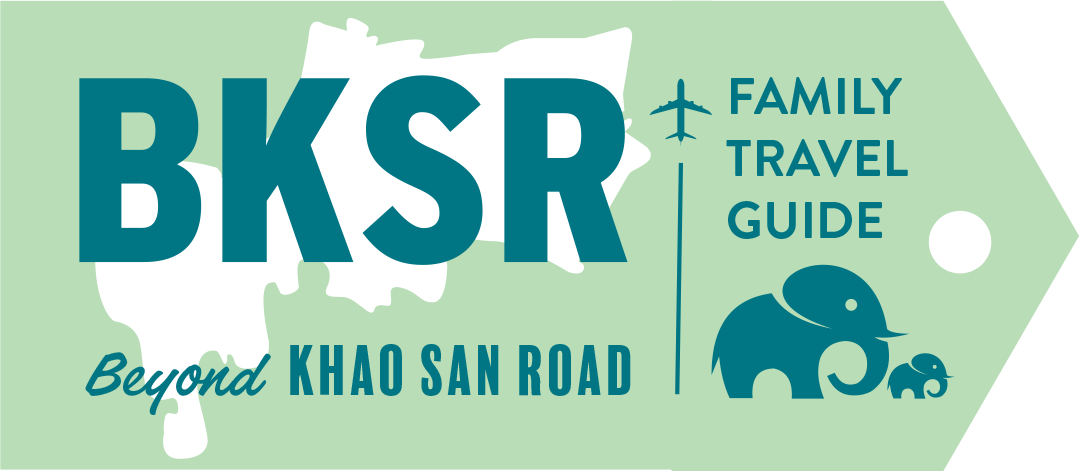Iguazu Falls is simply astonishing. With more than 275 separate waterfalls sprawling across 1.7 miles, a staggering 24.2 million litres of water per second plunge over its edge. The sheer scale of this natural wonder is hard to comprehend at first. It is nature in its most intense, raw, and powerful form. If you are planning on visiting Iguazu Falls Argentina with kids, then you are sure to witness something together that will create memories that last a lifetime.
We were lucky enough to spend four days on each side of the falls with our children and got to experience much of what they have to offer. As a spectacle, they are unrivalled; however, the national borders and the associated political intricacies do introduce some complications, particularly concerning currency and border crossings. These challenges are easily navigated, however, providing you know what to expect, and that’s precisely what we aim to explain here.

Please note all prices are correct at the time of writing, but with the Argentine Pesos in freefall and inflation running at 120%, they may be out of date before this blog post is a week old!
Put on your rain ponchos, grab some bug spray, and uncover the thrill and sheer beauty of this natural masterpiece, tailored for families seeking unforgettable moments in 2024. From the thundering cascades to the vibrant flora and fauna that call this paradise home, get ready to explore Iguazu Falls Argentina with kids.
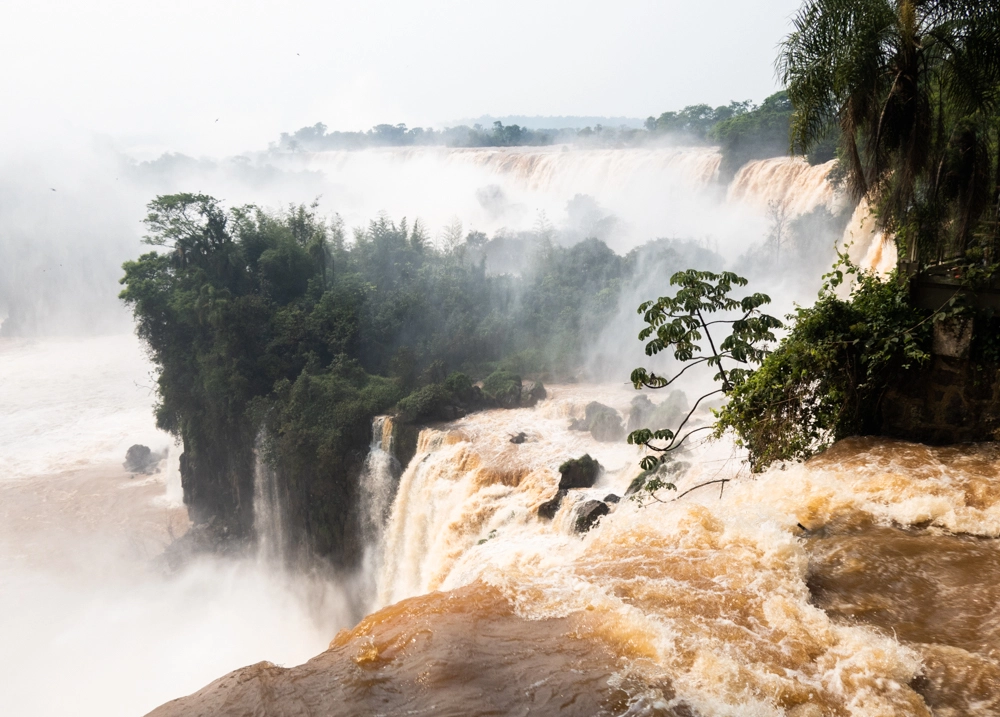
Large Sections of The Argentine Side of the Falls are Currently Closed
If you are considering visiting the Argentinian side of Iguazu Falls to explore this incredible place, be warned that as of December 2023, substantial sections of the park’s trails are closed to visitors.
We would estimate that currently, over two-thirds of the trails are closed until “at least summer 2024”, according to officials we spoke to at the park. Having seen the extent of the damage, it could be a lot longer.
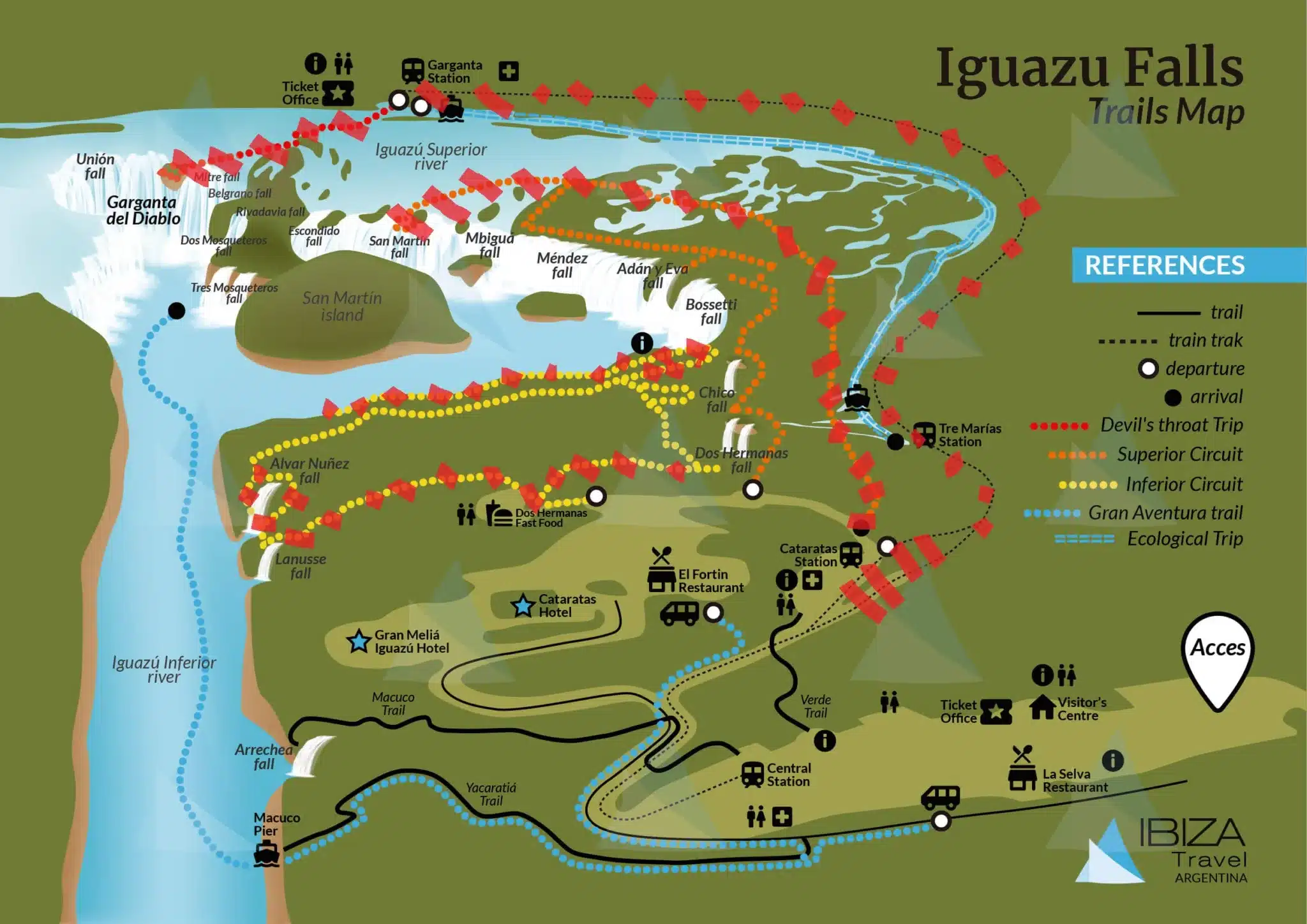
Click to see an enlarged version. Red lines show closed sections.
Following extreme rainfall in October 2023, substantial portions of the Inferior and Superior Trails were swept away. This also means these trails are no longer circular, so they are much more congested and slower to navigate with children as people are now walking in both directions. This is especially true if you have a pram.
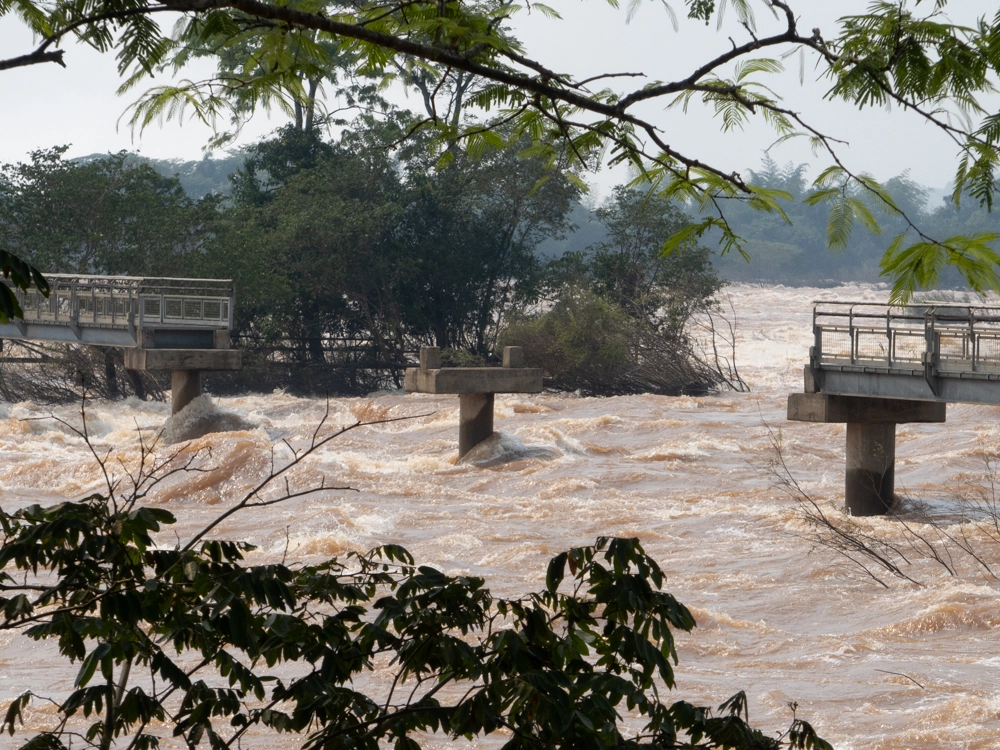
One of the washed-out sections.
Also, sadly, the Devil’s Throat Trail was damaged so badly that it is entirely closed, both by rail and on foot.
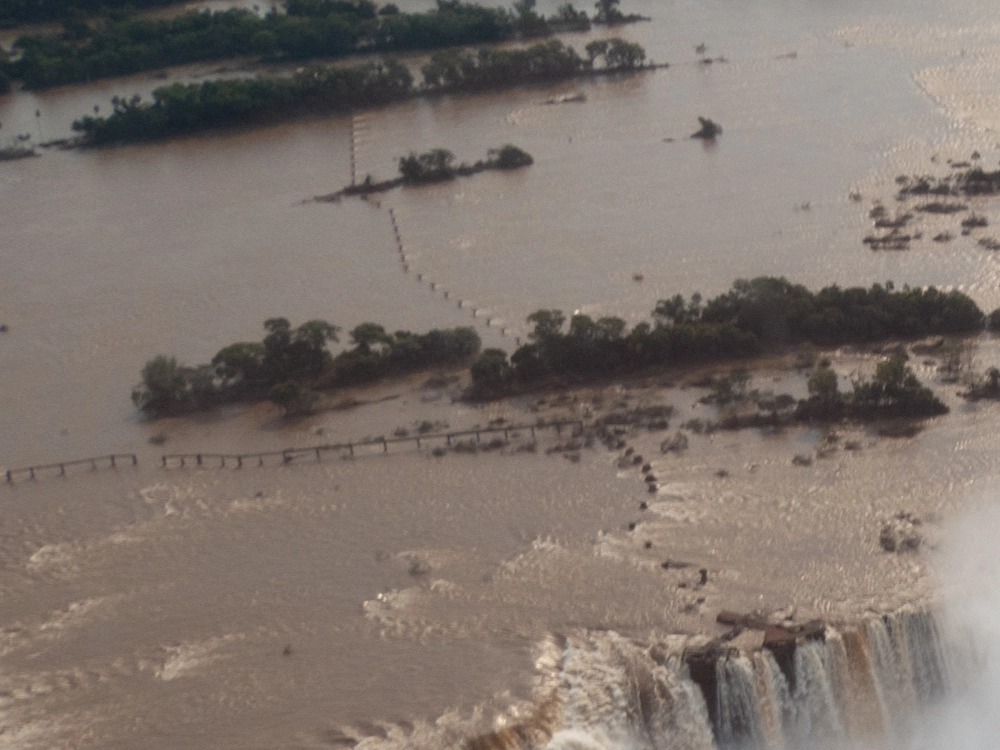
The dots are the remains of the foundations of the walkway.
While we loved visiting the Argentine side of the falls with our children, and there is still a lot to see, if you only have time to visit one side of the falls, we would strongly recommend seeing the Brazilian side for the time being.
Our Map Of Things to Do in Iguazu Falls Argentina With Kids
Getting To Iguazu Falls Argentina With Kids
As you would expect from such a major tourist destination, Iguazu Falls is very well-connected, especially if you are already in Argentina. The main town next to the falls is called Puerto Iguazu, and it is a genuine slice of Argentinian life. This is in contrast to its Brazilian counterpart, which feels like a watered-down Orlando. Although the town is well geared towards tourists with its wide range of eateries and bars, it still has a genuine charm and personality of its own.
While there is not as much to do with children on this side of the border as on the Brazilian side, you can fill a few happy days exploring the falls and other local attractions.
Most people arriving either take a short flight or a long bus ride from Buenos Aires. The airport is just a stone’s throw from Iguazu National Park and about a 25-minute drive from Puerto Iguazu. If you travel by bus (check out our guide to surviving epic South American bus journeys here), the Terminal de Omnibus is in the centre.
We have made some long coach journeys with Georgia and Eva, but given a choice between 20 hours on the road or 2 hours in the air, I know which we prefer! Internal flights in Argentina are so cheap that taking the bus does not make sense.
The final way to reach the falls is to cross over from Foz De Iguazu in Brazil. More on this later; for now, we would say if you are doing this crossing with kids, do it in a private taxi and, if possible, at about 3 pm. This is by far the speediest way to cross the border.

Where to Stay and Eat In Puerto Iguazu
If you are looking to book an Airbnb or planning to dine away from your hotel, the main streets for eating in Puerto Iguazu are Av. Córdoba near the main bus station and Av. Brasil is just a few blocks down.
Between these two streets, you will also find a number of supermarkets, good old tourist-tat shops and a laundrette. We used a laundrette called Lavanderia Express, which offers a same-day service if dropped off before 9 am. They charged us Arg$ 12,000 for two loads, which was ready by 2 pm. There did seem to be a bit of a tourist tax for us, but it did mean that we didn’t need to sit and wait for our washing to be done.
Also, there are several taxi offices around this area as well.
As with any town, there are nicer areas to stay in. However, the overall crime rate is pretty low, and we felt very safe during our visit. The locals were incredibly welcoming and friendly, especially to Georgia and Eva!
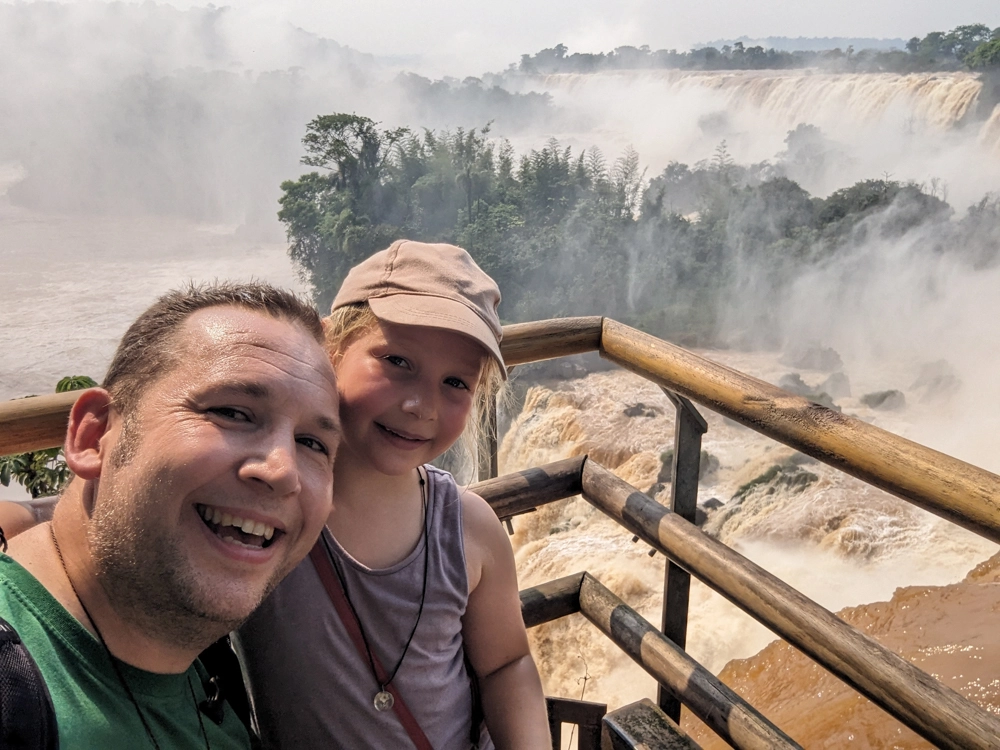
Getting Around Puerto Iguazu With Kids
Unlike many big cities in South America where driving is like a scene from “Mad Max”, the traffic in Puerto Iguazu seems very calm and we would certainly have considered renting a car.
That said, taxis are so cheap it does not seem worth the trouble. We paid Arg$ 12,000 to return to the park from the town centre, and the journey takes about 25 mins. Everything else in town was an easy walking distance.
Keep in mind that taxis almost exclusively take cash, more on how to get cash without getting ripped off below.
If you want to catch a bus, the Terminal de Omnibus is centrally located and a ‘Rio Uruguay’ service runs regularly and takes you right up to the entrance to the park. It takes about 30 minutes and costs Arg$ 1000 each. Kids and adults pay the same price.
Strangely, there were no Ubers available while we were there and speaking to the local taxi drivers; none operate in the local area.
Crossing the Border Between Brazil and Argentina
If you are coming from Foz Do Iguacu or considering experiencing the Brazilian side of the falls be warned that crossing between these great nations is not the smooth and quick process it should be for such a popular border. Indeed, you could almost wonder that the authorities deliberately make the crossing as arduous as possible to encourage people not to bother.
As you approach the border from either side, there are two major choke points. First, there is a huge traffic queue waiting to get to the border. Second, there is another huge queue of people waiting to get their passports stamped.
The first choke point is easily bypassed as taxis and tourist buses have their own express lanes that skip past private vehicles. The second is just a matter of timing. If you try to cross early in the morning, it can take over an hour to get through, with all the tourist coaches making the same journey.
We found the best thing to do was to cross the border by private taxi at about 3 pm. This gets you past the traffic quickly and means the queus at passport control are minimal.

Planning to visit the Brazilian side of the falls? Check out our full guide here:

Planning to visit the Brazilian side of the falls? Check out our full guide here:
Crazy Exchange Rates – Why You Should Never Use an ATM to Get Cash in Puerto Iguazu
Note: All information below is correct as of December 2023, but the situation is changing rapidly.
Strap in for this one! This has taken us some time and some expensive mistakes to figure out, but I think we have a handle on it.
The first rule of visiting Argentina is to never, ever get money out at a cash point unless you absolutely have to!
Why? Two reasons. First, there are eye-watering fees for using some cash points. At Iguazu Falls National Park, we were charged nearly Arg$ 5,000 when we withdrew the maximum allowed amount of Arg$ 10,000. That is right- close to a 50% fee!
Cash points in Puerto Iguazu are not much better, with charges of around Arg$ 3,500.
Believe it or not, that is not the worst of it.
What will really sting you is that in Argentina, there are multiple exchange rates depending on how you access your money. You will only get about 35% of the value of your money if you withdraw cash at an ATM compared to paying by international bank card.
Since late 2022, if we pay for services on our international bank card, we get the “blue dollar” exchange rate of approximately Arg$ 1,100 per £1. If we withdraw cash at a machine, we get the “official” exchange rate of only Arg$ 400 per £1.
I don’t know exactly why this is or how it makes sense, Argentina is the only country in the world where I have experienced multiple exchange rates depending on how you access their currency.
This issue is compounded by the country’s ongoing financial woes, which means many people, especially taxi drivers, refuse to accept bank cards. Simply put, cash is king here.
So, how to get hold of cash at a sensible exchange rate? The answer is Western Union.
Getting Cash Using Western Union in Puerto Iguazu
If you send yourself money using Western Union using an international card, you will get cash at the preferable “blue dollar” rate with minimal fees.
Download the Western Union app, set yourself up as a payee, and send yourself the money.
Getting hold of it is where things get a bit tricky! There are four issues:
- Currently, the maximum you can withdraw from Western Union in Puerto Iguazu per person per day is ARG$ 100,000. If you send yourself more, they will refuse to process the transaction, and you will have to jump through hoops to get your money back. Double-check this limit if you can; with inflation running so high, it may have changed by the time you read this.
- There is only one Western Union in Puerto Iguazu, and it does not open until 3 pm as this is when the money arrives.
- The queue is massive, so arrive at least 30 mins before it opens, if not more. Also, the process of getting hold of your cash painfully is slow (it takes 5-6 mins per person) and there is only one cashier so don’t expect the queue to move quickly. Bring water as you could be standing outside for some time. When we used the service, we arrived at 14.20 and were 6th in the queue. We did not receive our cash until nearly 15.45.
- You will need your passport to obtain the cash. Remember to take it with you!
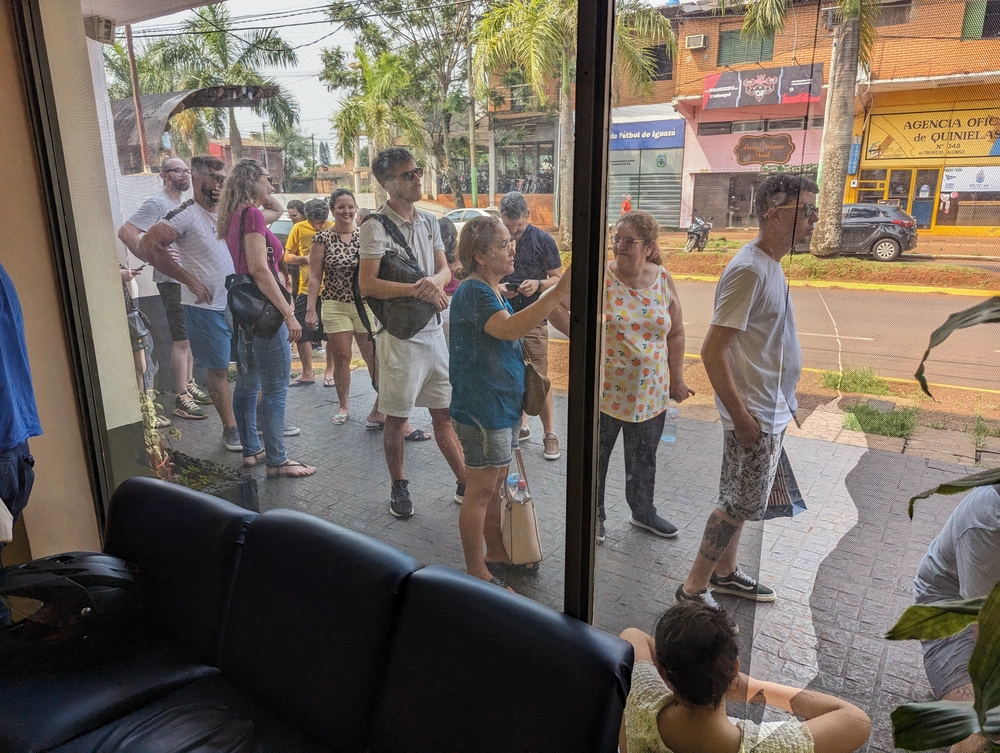
Kirsty and I set up separate Western Union accounts, and we both went so we were able to get Arg$ 200,000 out in one go, but this did mean bringing the kids with us.
A few other pointers are that your first withdrawal with Western Union via the app is free of charge, so make the most of it! The largest bank note in Argentina is Arg$ 1,000 so you get a wedge of cash if you take the full Arg$ 100,000 so bring a discrete bag to carry it in. Finally, if you are travelling up to Iguazu from Buenos Aires, try bringing as much cash as possible as the Western Unions down there have a much higher limit.
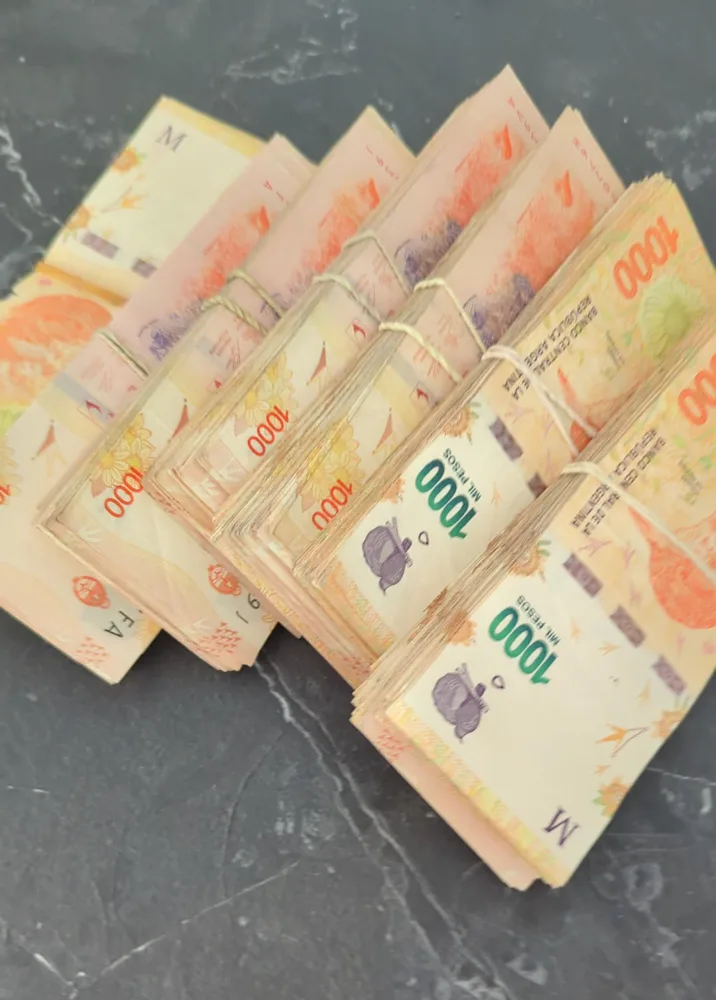
Visiting Iguazu Falls Argentina With Kids
The reason we are all here, so lets dive in!
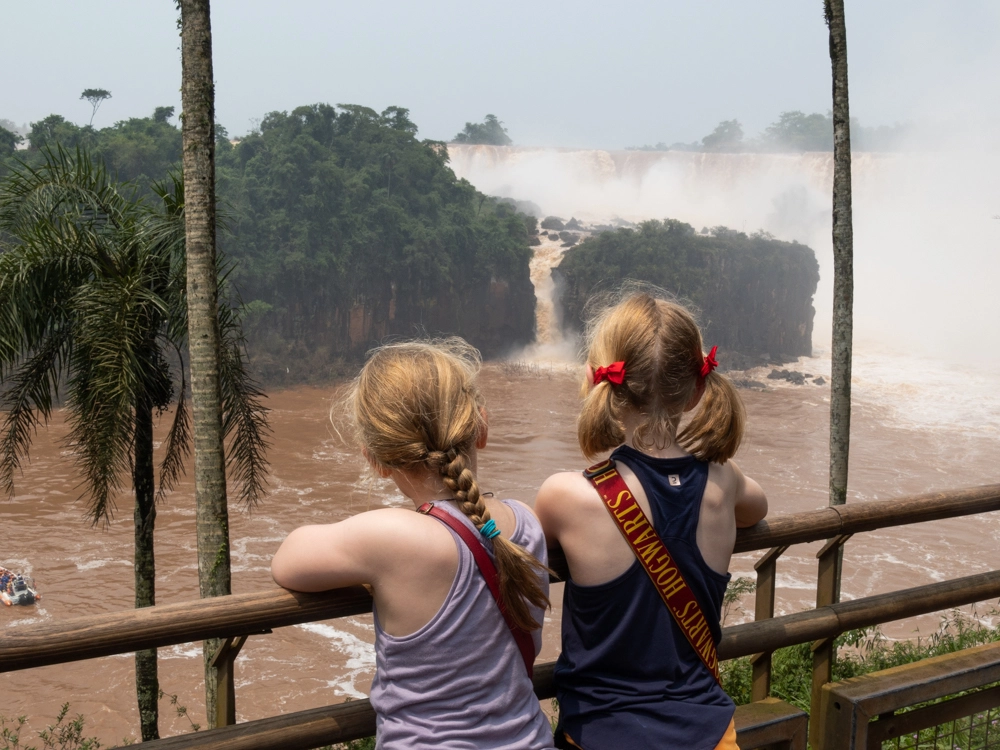
When To Visit The Park and Where to Buy Tickets
If you are visiting the park with your children, we recommend getting there as early as possible to escape the worst of the crouds and the heat. We visited the park twice in two days, and on both days, the temperature and humidity had become insufferable by 1 pm.
We also noticed most tours seem to arrive about 9 am, so try and get in before them. This does mean an early start though!
If you get into the park before the tour buses you get the place to yourself for maybe 20 minutes, and it is a wonderous experience, especially if you head straight to The Devil’s Throat.
The easiest way to get your tickets is online here, or you can purchase them at the park where you can pay by card or cash. We read multiple times that it was cash only; this is not the case as of Dec 2023. If you want to go for a second day (and there is plenty to fill two days at the park!) the tickets are half-price for the second day. Unfortunately, you cannot book the half-price tickets online; instead, queue up at the main ticket office and show them the previous day’s tickets to get the discount.
We paid entrance fees of Arg$ 20,000 per adult and Arg$ 10,000 per child on our first visit.
There is an option to hire a private guide at the entrance to Iguazú National Park for a cost of $40 USD (cash only) but we declined as we prefer to make our own way with the girls.
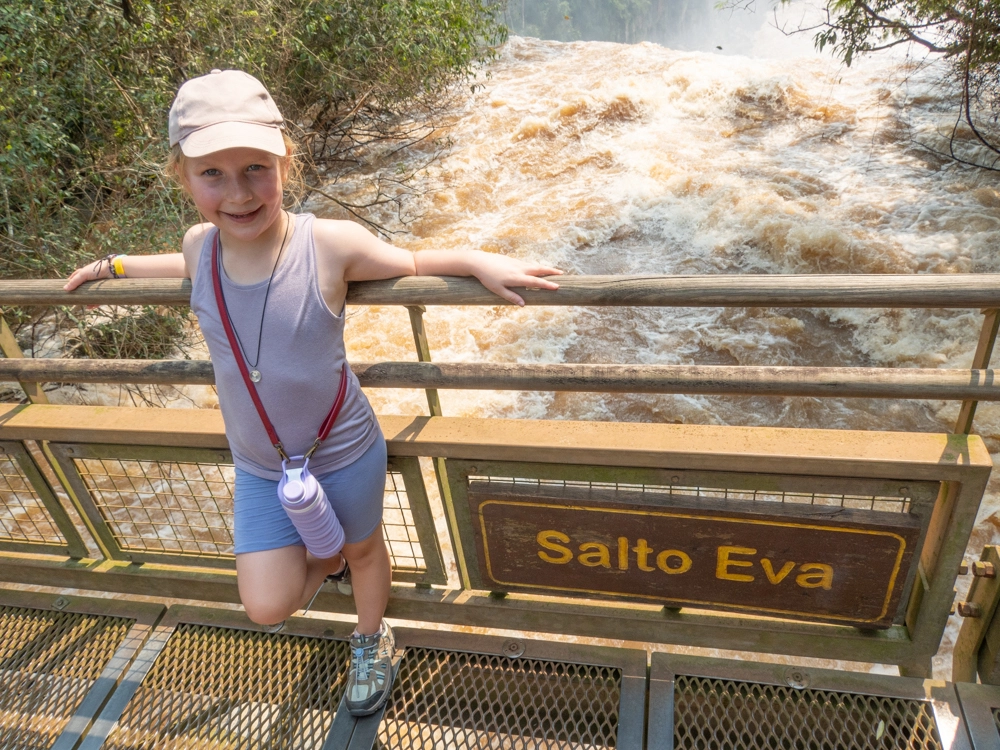
What To Take And Where To Eat In The Park
You do not need to bring anything too unusual! Pack plenty of water, bug spray, and sunblock. You don’t tend to get as wet as you do on the Brazilian side but we would still recommend taking a waterproof poncho.
If you have brought food to the park, there are plenty of places to stop and enjoy a sandwich or drink. If you plan to buy food, there are several cafes and restaurants near the main entrance and a few smaller ones scattered at the trailheads. As you would expect, the restaurants in the park are subject to a tourist tax but not to a ridiculous level.
When you eat, please be aware the monkeys and coatis are very keen on sharing your food! This is not helped by ignorant tourists feeding them to get their latest Instagram picture. Feeding these animals encourages human interaction, which is bad for all parties involved.
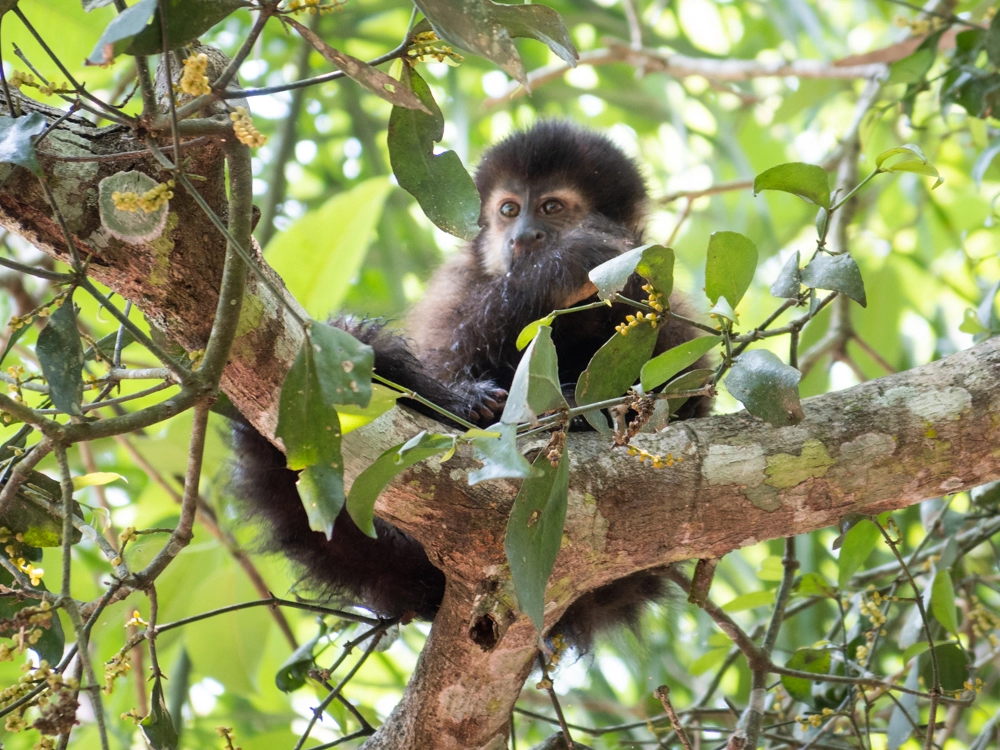
There are no bathrooms on the trails but plenty near the restaurants.
Exploring The Park With Children
Note: the information below is temporarily outdated due to the closure of some of the trails explained above (link).
On balance, we enjoyed the Argentine side of Iguazu Falls more than the Brazilian. The Brazilian side is a much better-organised experience but feels like a conveyor belt, you are herded along from start to finish with little deviation.
The Argentine side feels more like a park you can explore and experience at your leisure.
The park has three main trails: the Inferior Trail, the Superior Trail (both circular trails) and the Devil’s Throat Trip. Each trail will take up to a couple of hours to experience fully, with much to see along the way.
If you are visiting with young children, we would not recommend doing all the trails in one day, as it can be oppressively hot and humid by early afternoon. As mentioned above, you can get a 50% discount on your second-day tickets. We took advantage of this, and we are glad we did! Nothing zaps the pleasure out of ‘family day out’ more than trying to fit too much in!
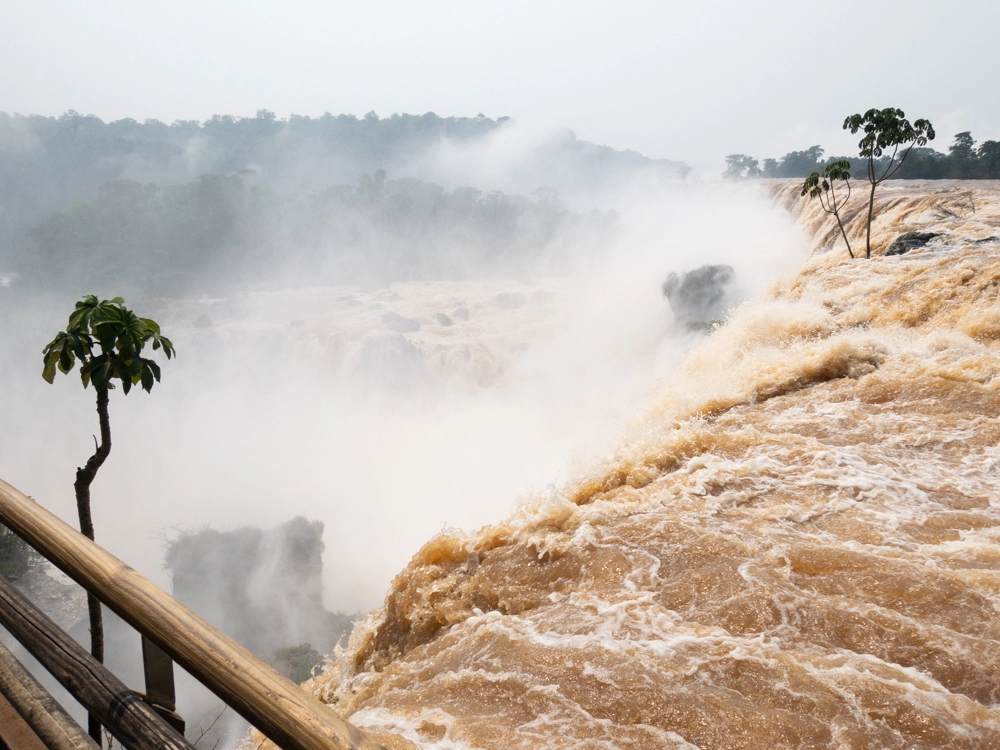
The Inferior and Superior Trail
When you pass through the visitor’s centre you can take a short train ride from Central Station to the start of the Inferior and Superior Trail. Whilst this has a bit of a novelty factor, we would recommend walking the short Verde Trail instead. This trail is slightly over 600m but goes through some beautiful forest. It is much quieter, and we were fortunate enough to see some incredible wildlife along the way.
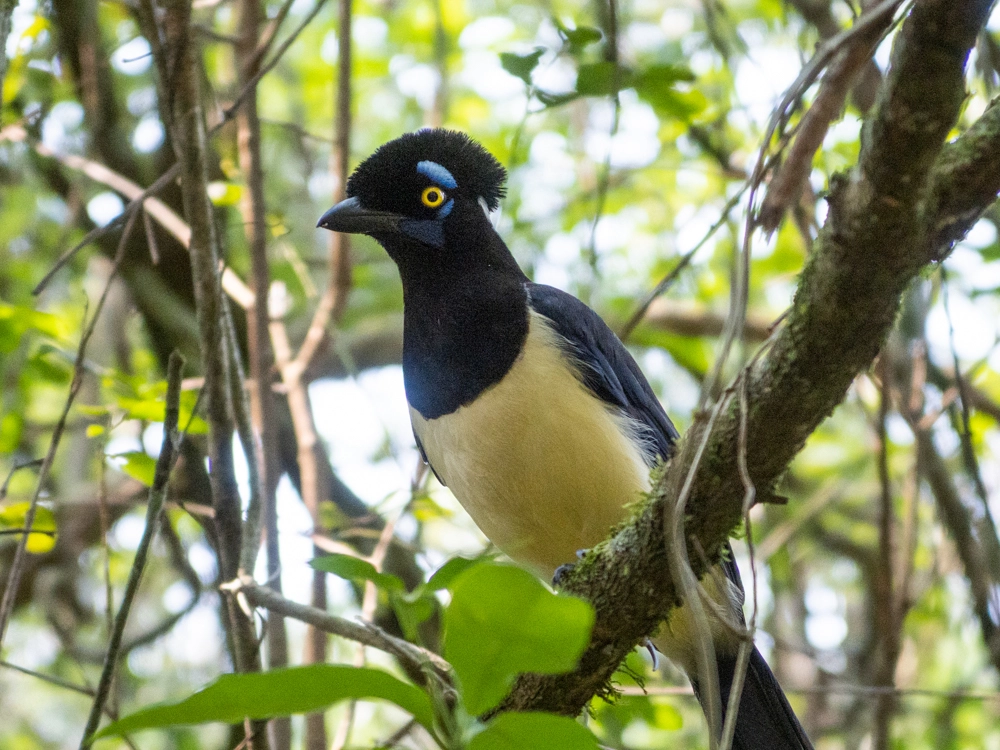
If you only have time to do one trail, do the Superior, as it offers mind-blowing views. It closely follows the top of the falls and gets you up close to the awe-inspiring power of this world wonder.
All the trails are well signposted and easy to tackle with a pram, and there was plenty of staff around to help out if needed. The main sections are all one-way, so they were not congested even when busy.
Another nice part of the Argentine side of Iguassu is that you get to see ‘teaser’ waterfalls along the trails. You can get up close and personal with some pretty impressive falls before the main attraction is revealed!
For the return journey, we took the train back from Cataratas train station, which was a happy little bimble. It barely takes 10 minutes to reach Central Station, but it was a nice break to rest our feet after a full morning of exploring.
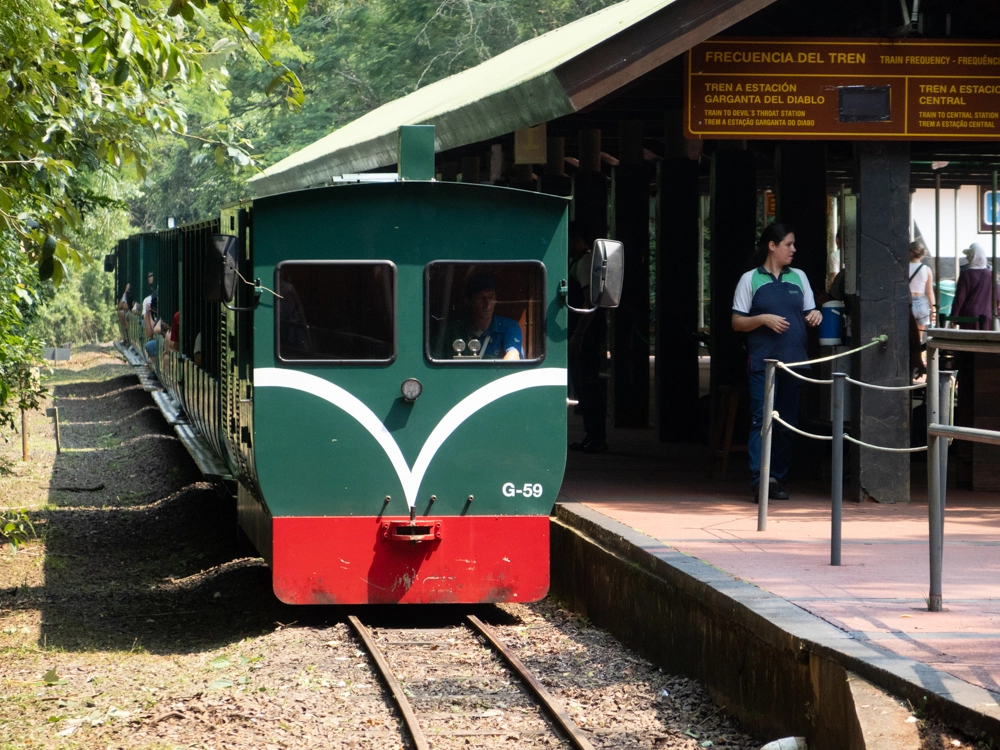
Devil’s Throat Trip
The highlight of any visit! The scenic train trip up to the Devil’s Throat platform gives astonishing views over the grandest part of the falls. Here, the only word that does the falls justice is “formidable”.
You have two ways of reaching the viewing platform, either on foot or by train.
The train runs about every 15 minutes but gets very busy during peak periods, so we recommend getting to the park before the tour buses and getting up there early. We have heard you can wait an hour for a train at the busiest times.
The alternative is to walk up. We didn’t do this with the girls due to the heat, but from the train, the path looked reasonably flat and easy to follow. Had it been a little cooler, we would have walked back this way. It is just over 2km to walk there and back.
Once you reach the Garganta Station, there is a walkway about 1km long that takes you to the “Garganta Del Diablo”
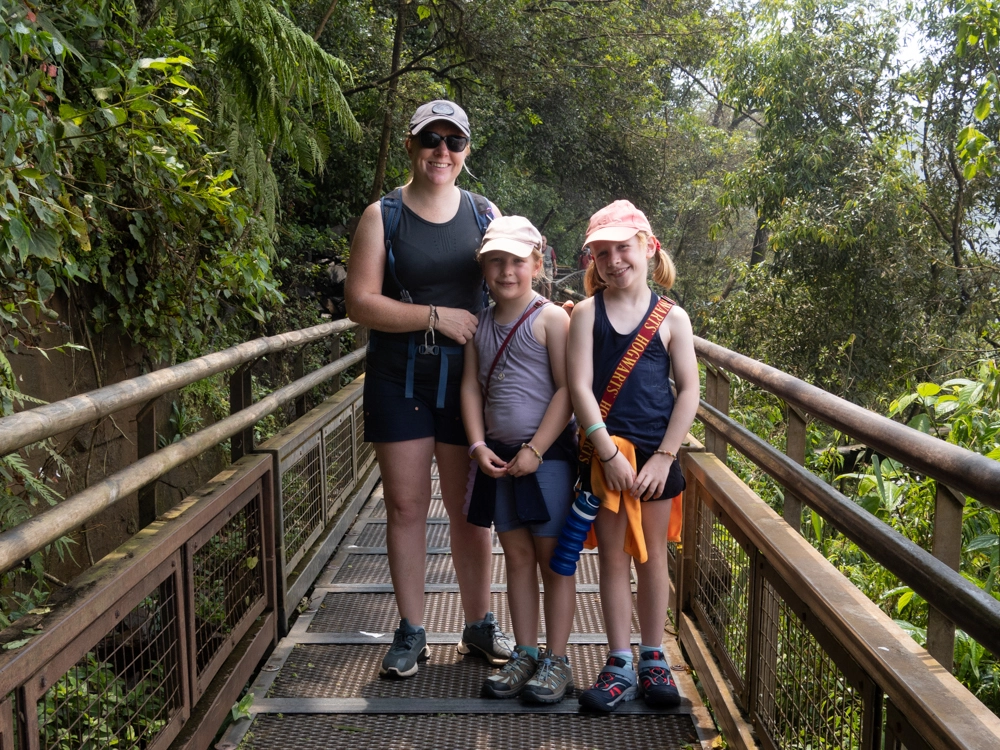
Other Things To Do In Puerto Iguazu with Kids
This is where Puerto Iguazu falls down compared to its Brazilian neighbour; there isn’t much more to keep kids engaged once you have explored the falls. It is a sign of the economic success of the respective countries that Foz Do Iguazu has seen substantial international investment, Puerto Iguazu much less so.
Güirá Oga Animal Sanctuary
The Güirá Oga Wildlife Sanctuary is an entertaining diversion for a few hours, but only if you speak sufficient Spanish. We had read that there were English tours twice a day at 10 am and 2 pm but this was not the case when we visited. If your Spanish is as limited as ours, check to see if they are running tours in English before you visit.
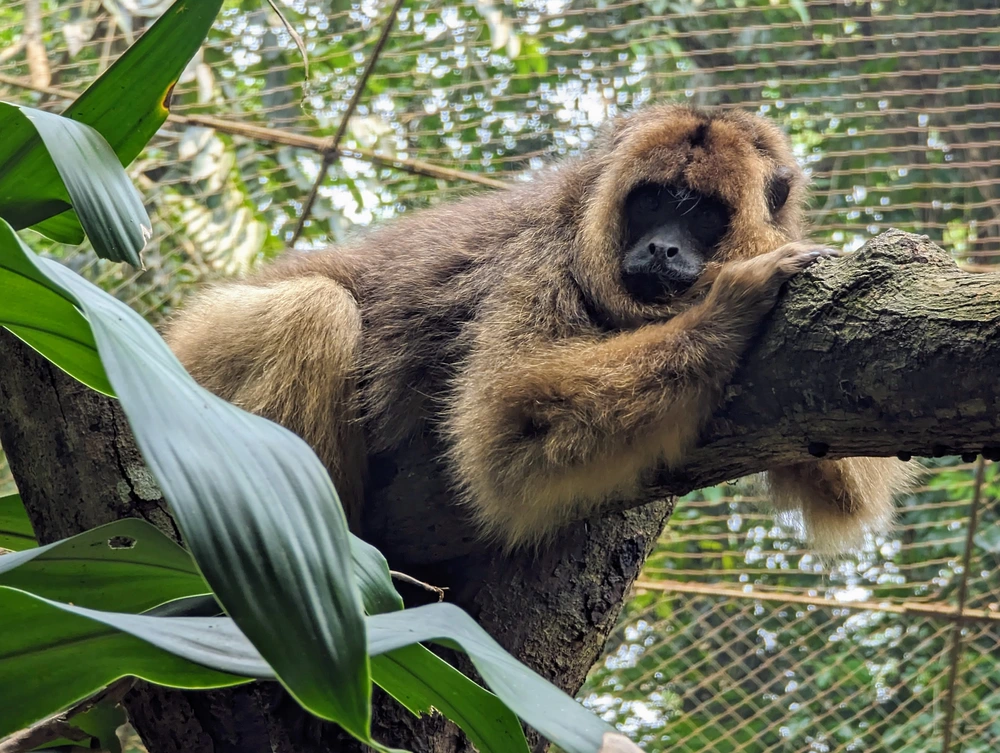
The sanctuary houses an array of rescued bird species, large cats and other animals in the process of rehabilitation and release. The tour takes a little over an hour.
Our favourites were the parrots, many of which were rescued after being kept illegally as pets. One of the few things we were told in English was that if they spoke to us, they should not answer them back as they were trying to break the habit! Can you imagine walking through Iguazu National Park minding your own business when a parrot screeches ‘who’s a pretty boy then’ out of the bush?
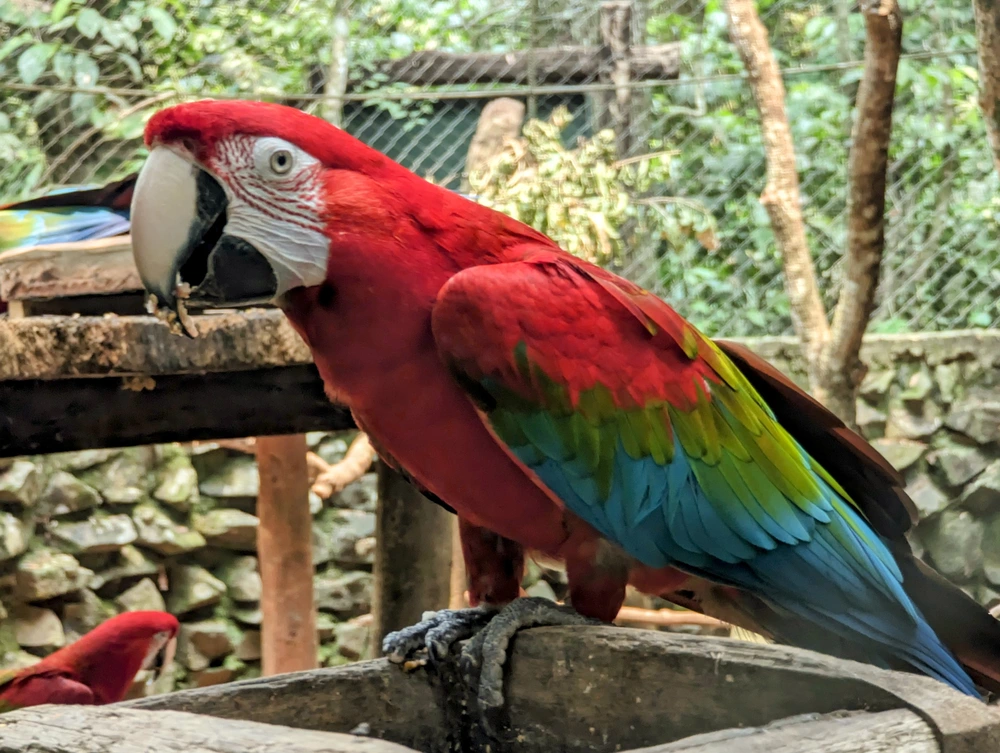
The animals all looked well cared for, and we were happy to see our ticket price go to support a good cause, even if the language barrier meant we missed a lot of information. It costs Arg$ 10,000 per adult and Arg$ 5,000 per child to enter.
Three Borders Landmark
The Three Borders Landmark, also known as the Marco das Três Fronteiras in Portuguese or Hito Tres Fronteras in Spanish, is an entertaining diversion if you are nearby. The landmark shows the confluence of the Iguazu and Paraná rivers, which form the borders between Argentina, Brazil, and Paraguay.
There is not much to do here, but the platform gives great panoramic views over the jungle and rivers. There is a small visitors’ centre with toilets and somewhere to buy snacks.
There is not enough here to fill more than an hour, but it is a pleasant enough distraction if you are close.
La Aripuca Ecological Preserve
La Aripuca is a mixture of living museum and conservation effort where you can learn about Guarani tribe, the ancient aboriginal inhabitants of Puerto Iguazu. The attraction also goes into detail about their efforts to raise awareness about the importance of protecting the rain forest and their deep connection with it.
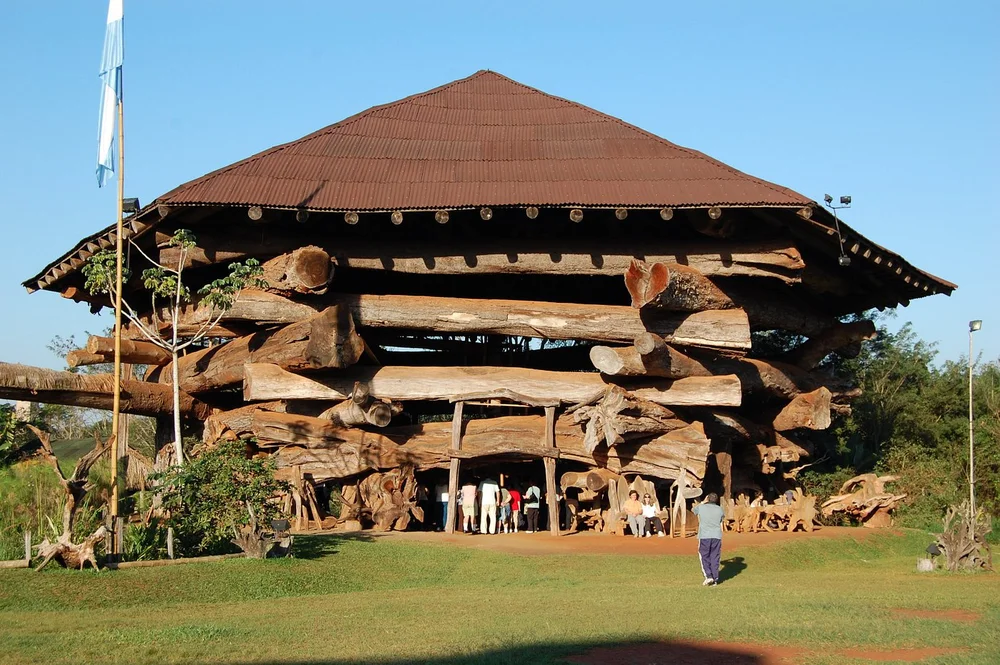
In truth, there is not a huge amount to see here and you can do all there is to do in less than an hour, it is a stop for a lot of the tourist buses and can get quite busy in the afternoon. It is worth a look if you have an afternoon to kill and the main building is very impressive, but it probably is not a “must see”.
Have We Missed Your Favourite Thing To Do in Iguazu Falls, Argentina With Kids?
We hope you have found the above information useful. We had an incredible time here, a treasured experience for us as a family.
As incredible as Iguazu Falls National Park is on the Argentine side, Puerto Iguazu could do with a few more attractions to make the trip here more worthwhile.
If we have missed anything, or if you have noticed any of the information here being out of date, please leave us a comment below!
